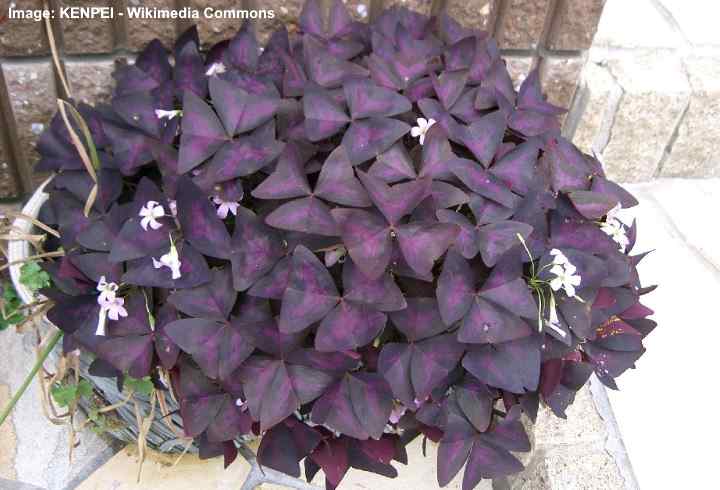A blooming perennial plant with triangular dark purple leaves, the purple shamrock (Oxalis triangularis) is a unique species. In gardens or as an attractive potted houseplant, the purple shamrock (also known as purple clover) thrives as a low-growing foliage plant. Love plant, purple butterfly plant, false shamrock, and purple Oxalis are some of the other names for this purple-leafed plant. It is a spectacular indoor plant for a bright location in your home because of its unusual form and dark purple close to black color.
How to care for purple shamrock: Grow bright light and plant in rich, wet potting soil with excellent drainage for the Oxalis triangularis to flourish. When the soil is somewhat dry, water only the purple false shamrock plant in moderate humidity conditions. 60°F to 75°F (15°C to 23°C) is the ideal temperature range. Every three to four weeks, fertilize.
The bulbous plant purple-leaf false shamrock belongs to the Oxalidaceae family, which includes wood sorrels. White blooms with purple and pink hues are produced by the flowering plant. The trifoliate leaves, which are comparable to those of clovers or shamrocks, give the plant its common names purple clover or false shamrock.
The way the leaves of these purple love plants close at night is an interesting feature. Like an umbrella, the leaves fold down at night. Other unusual houseplants, such as the sensitive plant (Mimosa pudica), are similar to this movement. Species of prayer plants are other houseplants with leaves that move.

The purple shamrock grows to be around 20″ (50 cm) tall and has a similar-sized spread. Its leaves close at night. The plant is also known as a purple butterfly plant because of the triangular leaves that comprise three triangle-shaped leaflets. In the summer, the perennial plant dies back, but regrows one month later. As a result, the phony shamrock seems to be in its dormant phase, even though it appears to be dying.
Apart from purple, the plant contains other leaf colors. Red Oxalis triangularis and burgundy shamrock are two cultivars available. Despite its fussiness, this unusual purple houseplant requires very little care. This purple Oxalis care guide aims to provide you with all of the information needed to keep this plant healthy.
Oxalis Triangularis (Purple Shamrock) Care Guide

Is it possible to guarantee that your Purple Oxalis plant grows well? The greatest care techniques for your purple-leafed plant may be learned by reading on.
Purple Oxalis Triangularis Light Requirements
Put your false shamrock in a sunny spot for approximately several hours of daily sunlight for proper development. You may get white spots on the leaves if you don’t protect the plant from direct sunlight. Yet, in order to maintain the leaves’ dark purple color, plenty of light is required. The clover or shamrock look is created by exposing the leaves to bright light.
In low-light situations, purple oxalis plants may thrive. However, as the stems stretch to get more light, they may develop a leggy tendency. Prune the plant and relocate it to a more brightly lit area if the foliage looks sparse. Pick a spot with dappled lighting if you’re cultivating a purple fake shamrock in your garden. To add stunning dark foliage to a patio, deck area, or balcony, you can also plant it in containers.
The Best Soil for Oxalis Triangularis (Purple Oxalis Plant)

Make sure to use well-draining soil when caring for purple shamrock plants. A combination of potting soil and peat is the ideal type of porous potting mix. A potting mixture that retains enough moisture but remains dry and waterlogged is the goal. The root bulbs rot in excessively wet soil.
When you water your potting soil, you can tell if it has enough drainage. Water should never collect on the surface, for example. Also, the water should quickly start escaping out the bottom of a purple false shamrock after it’s watered. You may experience a variety of problems with your plants if water drains inadequately, such as fuzzy white mold, fungus gnats, or sick roots.
Bulbs may also impact drainage if they take up too much space in the pot. However, later in the article, there is more information on it.
How to Water Purple Shamrock (Oxalis Triangularis)

When your purple Oxalis triangularis begins to wilt during its dormancy period, don’t water it. Pour enough water into your oxalis houseplant to make sure that it drains out the bottom. After that, wait until the top layer of earth has dried out before watering again. Letting it partially dry out prevents bulb rot while still getting enough moisture to the roots.
Water only when it is needed, rather than on a regular basis, with a purple oxalis plant. When should you water the purple plant? To determine if the soil is moist, press firmly on it. It’s time to water the soil if it’s dry. Wait a couple of days until the soil has dried out somewhat.
Remember that in the summer than the winter, your purple false shamrocks need more water. Also, don’t water the plant when it becomes dormant, as it dies back. However, let it rest for four weeks in a dark, cool place.
When it comes to watering, here are a few more Oxalis triangularis care tips:
- Use water that is room temperature.
- Only use filtered or rainwater for drinking. Let the water sit for 24 hours, if possible, to allow harmful chemicals to evaporate.
- Water deeply to nourish the roots.
- Never allow the bulbs to rot by overwatering the plant.
Temperature Requirements for False Shamrock

Purple shamrocks houseplant thrives in cooler temperatures when cultivated indoors. Therefore, maintain a temperature of 60°F to 75°F (15°C to 21°C). purple false shamrocks tolerate USDA zones 8 to 11 and thrive in outdoor climates. During the night, the lowest temperature is 55°F (13°C).
Houseplants require protection from temperature fluctuations, including the butterfly purple plant. The sun, for example, may make the plant uncomfortable if it shines straight into a window. Also, avoid drafts, hot radiators, and direct air conditioning airflow. Cooler rooms with consistent temperatures are ideal for growing purple shamrocks.
Purple Shamrock Indoor Care: Humidity
False shamrocks have no particular humidity requirements, however. The plant does not need to be misted to raise air moisture, so the overall room humidity is ideal. Household heating may dry out the air in the winter. Thus, a little misting with a fine spray would be beneficial if the leaves are beginning to wilt. Just keep in mind that if the soil is dry, you should never water the plant.
Fertilizer Requirements For Oxalis Triangularis (Purple Shamrock)

During the growing season, fertilize your purple butterfly plant monthly. Purple false shamrocks benefit from a diluted houseplant liquid fertilizer as the best fertilizer. Instead, you may utilize a gradual-release fertilizer that requires just three months of use at the start of the growing season and then again three months later.
Mineral salts are a problem that many houseplants have when they’re given extra fertilizer. Minerals salts tend to build up in potted indoor plants since they do not flush away in garden soil. Flush the soil on a regular basis to prevent fertilizer buildup and plant root damage.
This is what you should do to care for indoor plants by flushing the soil:
- Place your purple shamrock plant in a sink or bath.
- To flush out excess mineral salts, gently run water through the soil for two to three minutes.
- Let the pot sit for a while with no water in it.
- Put the plant in a well-lit area.
- When the top layer of soil has dried out, resume watering.
Purple oxalis plants go dormant during the fall and winter. As a result, at this time, you should stop feeding and watering.
How to Prune Purple Shamrocks (Oxalis Triangularis)

The pruning requirements for false purple shamrocks are minimal. Indoors and out, the plant produces a natural bushy growth. When the plant declines or dies back, all you have to do is pinch off dead stems. Wait until the leaves and stems are dry before you observe that the vivid purple color has started to brown.
It’s time to trim the oxalis plants now. Move the plant to a cool, dark location if you prune off the dead leaves and stems. Rest the houseplant for three to four weeks. Return to a bright environment and water normally after that.
Oxalis Triangularis Propagation
To grow a new plant, you can cut the bulbs of a purple shamrock in half. False purple shamrocks are best propagated during dormancy. Just gently separate the bulbs, and then transfer them to a new pot. This is what you should do to propagate a purple oxalis shamrock:
- Trim off any dead or brown foliage once the plant has died back.
- Remove the dirt from the bulbs by gently removing the purple shamrock from the container.
- With your hand or a sterilized knife, divide the bulbs.
- Fill pots with the suitable potting mix and replace the new bulbs.
Planting (Oxalis Triangularis) Purple Shamrock Bulbs
It’s simple to grow purple shamrock bulbs. New stems and vibrant purple leaves will emerge quickly when the bulbs are well-drained in potting soil. Panting Oxalis triangularis bulbs is this way:
- Fill a one-third full container with the correct potting mixture and then add drainage holes.
- Place three or four purple shamrock bulbs around the container, spaced evenly.
- Fill the pot with 1.5″ (4 cm) of potting soil so that the shamrock bulbs are centered.
- To encourage growth, thoroughly water the potting soil.
- In a sunny, warm place, set the pot.
- You may see new development after two to three weeks.
- When the top layer of soil has dried out, only water the new plants.
The most important care tip when growing Oxalis triangularis bulbs is to avoid watering the soil excessively. As a result, do not water the newly developing oxalis bulbs excessively.
Repotting Oxalis Triangularis
Repotting every few years is all that is required for the Oxalis triangularis (purple shamrock) plant. Repotting a purple oxalis plant for either potting soil refresh or growth to a bigger container is beneficial. Plant purple shamrock bulbs according to the procedures for repotting an oxalis plant.
If you want your triangular-leafed plant to grow bigger, change the pot 2 inches (5 cm) bigger than the current one if you’re just repotting the potting soil. Change the potting soil, but use the same size of pots, if you are separating the offsets to propagate new shamrock plants.
Is Purple Shamrock Poisonous?
Cats and dogs should not eat purple shamrock (oxalis triangularis) plants. The poisonous oxalic acid-containing sorrel belongs to the Oxalidaceae family. Shamrock plants are poisonous to cats, dogs, and horses, according to the American Society for the Prevention of Cruelty to Animals (ASPCA). Your pets, on the other hand, are unlikely to begin chewing on the plant’s leaves since they taste bitter.
Oxalis Triangularis (False Shamrock) Dormancy Period
When it appears that the plant has died, most bulb plants (including purple shamrock) have a dormant period. The leaves stay shut in daylight and it appears to lack vitality when a false shamrock is getting ready to go dormant. The purple plant will usually revive after some relaxation, which is a normal occurrence.
It’s usually a indication that the plant is going into a rest phase if you notice it appears to be dying. Therefore, until the leaves and stems dry out, do not water. Move the plant to a shady, cool area and prune any dead leaves. Wait three to four weeks and then place the pot in a bright area with water to help revitalize your purple shamrock.
Common Diseases and Pests that Affect Oxalis Triangularis
Pests and diseases can attack purple shamrock plants, just like any other houseplant. Root rot caused by over-watering is the most prevalent kind of shamrock illness. Mealybugs and spider mites are the most common types of pests that affect your purple foliage plant.
Purple shamrock pests
Mealybugs—The white fluff or cotton-like pests stand out against the dark black or purple foliage and appear like little pieces of white fluff or cotton. White splotches on purple plant stalks are what some people describe them as.
Spider mites—Webbing on or under purple shamrock leaves is a common symptom of spider mites. In comparison to mites, spider webs are more obvious.
To learn how to eliminate pests that may kill a purple shamrock plant, please read our article on how to get rid of bugs in houseplants.
Purple shamrock diseases
The most frequent kind of fungal disease that affects the development of your Oxalis triangularis (purple shamrock plants) is called Fungal diseases. What is the most prevalent cause of fungus infections in houseplants and slow growth? Watering above and beyond normal amounts. Check the soil moisture if you notice slow growth, white mildew, or sagging leaves. In moist, but not overly wet soil, purple shamrock plants flourish. This is what you should do to address issues with fungal illnesses:
- Remove the top 1-inch (2.5-cm) layer of soil and scrape off any signs of white mold.
- Wait until the top layer of soil dries out before you stop watering your plant.
- Repot your plant with a fresh potting soil and water it appropriately if it does not recover.
FAQ About Growing Purple Shamrock (Oxalis Triangularis)
Do you want to learn more about this unusual purple butterfly plant? These are the solutions to a number of frequently asked questions.
Why is Oxalis triangularis called false shamrock?
The plant has three petals that resemble shamrocks or clovers, hence the term “false shamrock.” The plants, on the other hand, come from several families and feature distinct forms of leaves. The purple shamrock has triangle leaves, whereas clovers and shamrocks have little oval leaves.
What are those white spots on my purple shamrock plant?
Many reasons for white dots or patches on purple shamrock leaves are possible. You might have a pest problem or Powdery fungus might develop as white spots. Sun damage might also be a cause of white leaf spots.
The creamy-white patterns on the leaf might be a fungal problem if the soil is too wet. The issue should be resolved by reducing watering frequency. It’s likely sunburn if the white spots dry out and create holes. As a result, move the pot away from the sun or provide some shade.
Do purple shamrocks flower?
False shamrocks (oxalis triangularis) bloom every spring under the right conditions. Little white trumpet-like blooms bloom with them. You may see delicate pink and purple hues up close.
Can purple shamrocks be planted outside?
In bright, sunny outdoor environments, Oxalis triangularis thrives as a low-growing foliage plant. In the backyards, the lovely purple leaves may be used as borders or small bushes. You may dig up the bulbs in the autumn and replace them with fresh ones to keep them safe from frost if you reside in colder areas.
Do purple shamrock leaves close at night?
Light levels affect false shamrocks, and they fold their leaves in low light. The leaves fold down in the evening, forming upward-pointing shafts on the stems. The leaves reopen when the light becomes brighter.
How long does a purple shamrock plant live?
Apart from a dormant period in the summer, purple oxalis plants grow all year. For a month or so, these perennial foliage plants need to relax. The purple leaves turn brown and fall back during this period.
As a result, don’t assume your plant has perished just because it hasn’t grown. For two to four weeks, relocate the plant to a cool, dark area. Then, to revitalize your plant, transfer it to a sunny spot and water it adequately.
Why does my purple shamrock seem to be dying?
Your purple faux shamrock should grow year after year if you are treating it properly. As a result, if your plant appears to be dying, it is most likely going into dormancy. The gorgeous purple or maroon leaves should reappear after a few weeks.
Why are the Oxalis triangularis purple leaves turning yellow?
The cause of purple leaves becoming yellow is usually because too much water. Over-watering or poor soil drainage may be the cause of the yellowing leaves. Don’t water until the top 1″ (2.5 cm) of soil has dried out to help restore its purple vibrancy.
